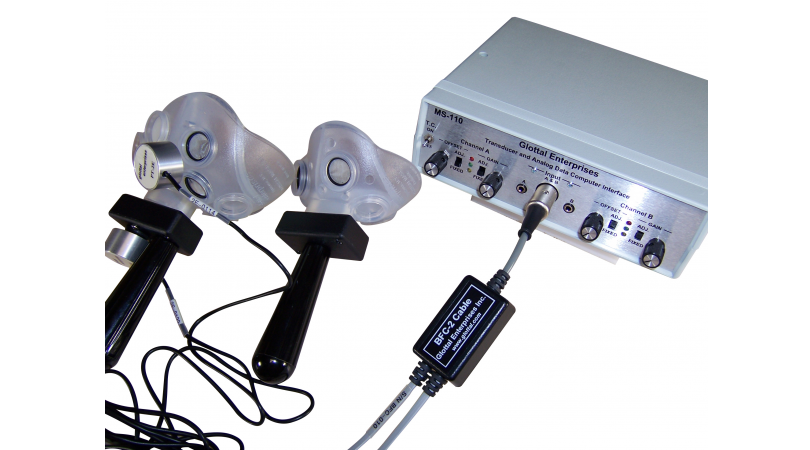2238 阅读 2020-02-18 15:32:24 上传
This video will go through the process of inverse filtering to obtain the airflow waveform at the glottal during a vowel.And in in inverse filtering, we start out either with an airflow signal as measured using a cv mask and that measures the airflow at the mouth.All we can use a microphone to get the pressure signal at the mouth.It should be a army directional electret microphone, or sometimes called the capacitance microphone and it should be held a few centimeters from the mouth As I am. I'm holding it here ,now,the inverse filtering we'll be doing today will be from a microphone signal.And This is measuring the pressure waveform at the mouth.and the inverse filter will,extract from that the airflow waveform,at the glottis are in the larynx.Now, looking at the, what I have here now is the waveform,of a pre recorded signal of me saying,pa pa pa,pai pai pai,Let's play this.I can play this back from the way view screen,and i'll click on original.pa pa pa,Ok So this is a syllable pa pa panow,the signal the original signal that will be on the center screen,the Top screen will show the ,results of filtering as we go through the different filtering stages.and now it's the same as the middle screen,because we have all the filters turned off.Now,i'd like to point out that there is a problem in this recording.And Now, it and we'll get around the problem but you should be aware that if you look at the center Pa, it's flight at the Top.And This is because the signal was recorded slightly too high.It's signal should look like more like the 3rd.syllable or any one of the syllables.And so this is called clipping.And so when we inverse filter will take something from the 3rd syllablenot the second.It's only a slight amount of clipping,but it's enough to do some to make some distortion in the waveform.Okay,now,Before inverse filtering.I will change the put enough an integration.step to make that wave form the the the flow. Instead of the pressure to do that, I click on integral. Here,Now We have airflow. well but actually, air flow is on both wave forms.And i'll expand the amplitude scale.And generally you wanna keep the the amplitude scale are large aha strong, so that you see the waveform in detail,as long as you don't go scale.The gain setting doesn't affect the operation of the filter how much you see on the screen So you're Free to to pick any amplitude scale that you want,Even if you're have the inverse filtering won't be affected.Okay, I have it now. It again times four.and in the integration is on now and I notice on the bottom, we have.the first three formants first, second, and 3rd formant, and a low pass filtercalled a smoothing low pass filter,which takes that energy above the cutoff frequency. Here,we'll take that the formants one by one. What you're seeing on the screen is mostly first formants energy.So we'll take out the first formant.to adjust the first formant,you have to eliminate the second and 3rd formant It's approximately using the smoothing low pass filter Now we could then so we could set that low pass filter above the range that the first formant could be at,And I have it here set to 1200 hertz Now if I turn off that filter,so now that puts second and 3rd formant energy in there.But if I turn it on its removes the second and 3rd and just leaves the first.So Now I could adjust the first formant by the following procedure.And you could see that that now you have just one formant Here,The first formant, and we could click on the period we can determine the period of the first for me by clicking on to succeeding peaks in the waveform.And In For Information bar on the screenit'll say that the the period is 1.4 milliseconds The reciprocal of that is the frequency of the first foreman,which is 711Hz And So we want to set that to 711Hz. Now i'll turn on the first formant.Now it's set to for 90.Now, the damping of the formant is set to 0.04, which is a good setting for a microphone signal.And the second and 3rd formants I set to 0.03 And 0.02. Now those values of damping, zar default values, and their good for a microphone signal,and it is no need to change them now,I can turn up the frequency of the filter by clicking on the arrow here Or I could set use the cursor by the side of the first formant and move it up.Now. And you notice as I get past 711, the first form an energy goes out,there's 720 And then comes back in again. So we can zero in are right. There is a minimum value of the first formant 737 Now I want to get it down to close to 710.and so i'll use this to go.I'll use the arrow which enables me to do a finer tuning.Here is 640,660, and 670,and 700 there's 720,okay, 715, 710. So now the first formant is removed from here.What you're seeing on the screen is the second formant.The low pass filter did not take this out entirely.so now we will then proceed to take out the second formant.Now to do that will move the low pass filter above the second formant, i'll pick 1600 hertz.Now that's taking out the 3rd formant and the fourth,but leaving in the second formant. And what you could see here, is the second formant.Now the second formant filter is off,and i'll try to to measure the frequency of the second formant on the screen,Now I'm gonna turn up the Gain And it's going off screen on on the Top but it doesn't matter Now I could see the the second formant of oscillations more Clearly,And I try to get the same place in the cycle.we're to succeeding,Our successive oscillations, and I get a period of 0.91 milliseconds whice is equivalent to a frequency of 1100Hz, and so i'll have to set this the second formant and filter to 1100 hertz.First, i'll turn it on.And You could see that even 1300 Hz takes out a lot of it. But to get it down to a minimum, I could set the frequency closer to 1100 hertz.Now I have the first and second formant filters out now,And what's left is the 3rd formant, I'll turn up the low pass filters.Because that's decreasing the amplitude of the 3rd formant 2200 hertz,which is above 2300, 2400 which is above the 3rd formant,maybe 2500hz, That's above the 3rd formant And so the 3rd formant so that's above the second formant.so it's taking out the 4th, leaving me with the 3rd formant.So now i'll expand this a little more,and i'll do the same procedure, picking to Successive oscillations I marked with the left cursor in the right cursor.And I have a period of 0.45 milliseconds a frequency of around 2200hz, which would be the 3rd formant.So I have actually the 3rd formant. It is set pretty close to 2200 hertz. So when I turn it on the 3rd formant, it disappears.And i'll turn this down to 2400,2200.Now again, if we take the move the slider up and down, we can see the effect if it's set too high, the 3rd formant comes in.and if it's set too low, the 3rd former comes in and it goes at the minimum occurs that about here, which is above 2200 hertz.Now What's left? The remaining oscillations are the fourth formant.And if we turn off the low pass filter, we can see the fourth formant and the fourth form.We have no filter for the fourth form and done in wave So we used a smoothing low pass filter set 2500 hertz,which is or maybe 2400 hertz to take out the 4th formant.So.Right now,if i reduce the again to bring it on screen,i can cee the glottal ports And you could see that the glottal point of glottal closure is here,zero airflow is that this the center line here by if you're inverse filtering pressure. so zero airflow is really this part of the waveform.And then right here the vocal folks start to open in the airflow increases.And if we want to know the fundamental frequency, we can click at two successive glottal closure points.and we get an interval of 6.49 milliseconds,which is a fundamental frequency of 154 hertz.And That was my fundamental frequency in saying, pa,okay,If I change the time scale to get the entire syllable,you can see that the this was the the closure for the pa and the release was at this point. And then the aspiration comes here. And then the vocal folds are from coming together at the end of the period of aspiration.And then you have the voicing Now there's one other step here.Let me expand this again.Now in a microphone signal,there is low frequency phase distortion.And we could take that out or cancel most of it this is the signal by using the low frequency phase compensator for channel A channel B there is no channel be here. I only recorded airflow normally We would have perhaps electrical at a graph signal on channel B but there was no electrical autograph signal here for channel B actually, the compensation was on.Without the compensation, you see there is a slope to the zero flow level here,which is not in the glottal flow signal. So i'll turn the compensator on,and the compensator is set If you wanna see how it's set advanced options. It's set to a 40 hertz,which is a good setting for a typical microphone.If an a reversal filter and the different set is available at 20hz which is less filtering 40 hertz and a lot of filtering 20hz and 40hz,and 40hz is a good setting,so i'll accept it.Okay, so their the glottal pulses,now we can look at the flow declination rate, which is the slope.In the closing phase And that's of interest sometimes we can differentiate this signal.That gives you the rate of change.Now, since we already integrating it, if we take off the integration by clicking on neither, that's equivalent to differentiating the airflow,and that's a little or scalelike and move it. And so this shows us the rate of the rate of change of airflow.between here and here is the maximum rate of change.And If we go back to integration,we could see that that was it's a pretty much straight line.between there and there.And the by clicking out we could get a measure of how what the rate of change was in that period.Now,this was the silver a .Let's try that with the syllable I Now, if I go back.And,Getter to set 640 milliseconds.I could set. Now let's do it.Now that's pa pa pa, let's go to and i which is here Now take two click.I'll take some part of the steady state, and put the left and right curses in it and expand. And look, that'll show me the waveform ah,you notice what's happened is in ah the second formant is a little higher than I so the second formant energy is not removed.First formant and energy is about the same. if we we want to change the second formant,we can measure the frequency here.Again,Of the second formant I can just a little bit of 3rd formant in there I could take it out by bringing down the low pass filter.There is a second formant,Now, if I click you want to get the the same part of the,the same part of the cycle on both.And both the oscillations,And We look at, we find a period of 0.73 milliseconds,which is equivalent to.A frequency of 1378 hertz, or about 1400 hertz.So Now let's go back and turn on this.Well The second formant filter is on already So Now.Now i'll Raise the frequency to 1400 hertz.And That takes out the second formant.And So we now we have a waveform which is similar to the one for the gladly airflow is is not much affected by whether you have a novel or an adult.So this is the inverse filtering,so that's that's the inverse filter process for for microphone signal in two different vowels.And again, we can see this is the closure period.And Then you have the explosion and the aspiration. And then a period of steady state vowel. Here,Now I used the syllable.Pa,And Pai, I put a p there. And one reason for that is that if you say p you close your velum tightly of to create a pressure.And So the the villa moles will remain closed during the vowel.In general,And So the inverse filtering. if you leave the villa open, and instead and the inverse filter process will not work as well.So i've removed the nasal i've ensured no nationalization during the vowel by using a p consonant.And that's it.All right.We have available, incidentally, automatic inverse filtering by listening to the vowel and clicking on on this chart of F1, F2, we can do some automated inverse filtering.Now Here's the waveform for I and I is this vowel here.And you can see that's not quite accurate.So this is be roughly in a.You can see the so we get approximate inverse filtering by using this chart. And sometimes that's convenient at to give you a starting place for the F1, F2, and F3 values.But as you could see,is not accurate.It was 1720 and it was really supposed to be around 1400.So This is just an approximation.we have a comparative here, filter one.we can record the values that we're.You could read your manual to find out how you can record these values without writing them down.












